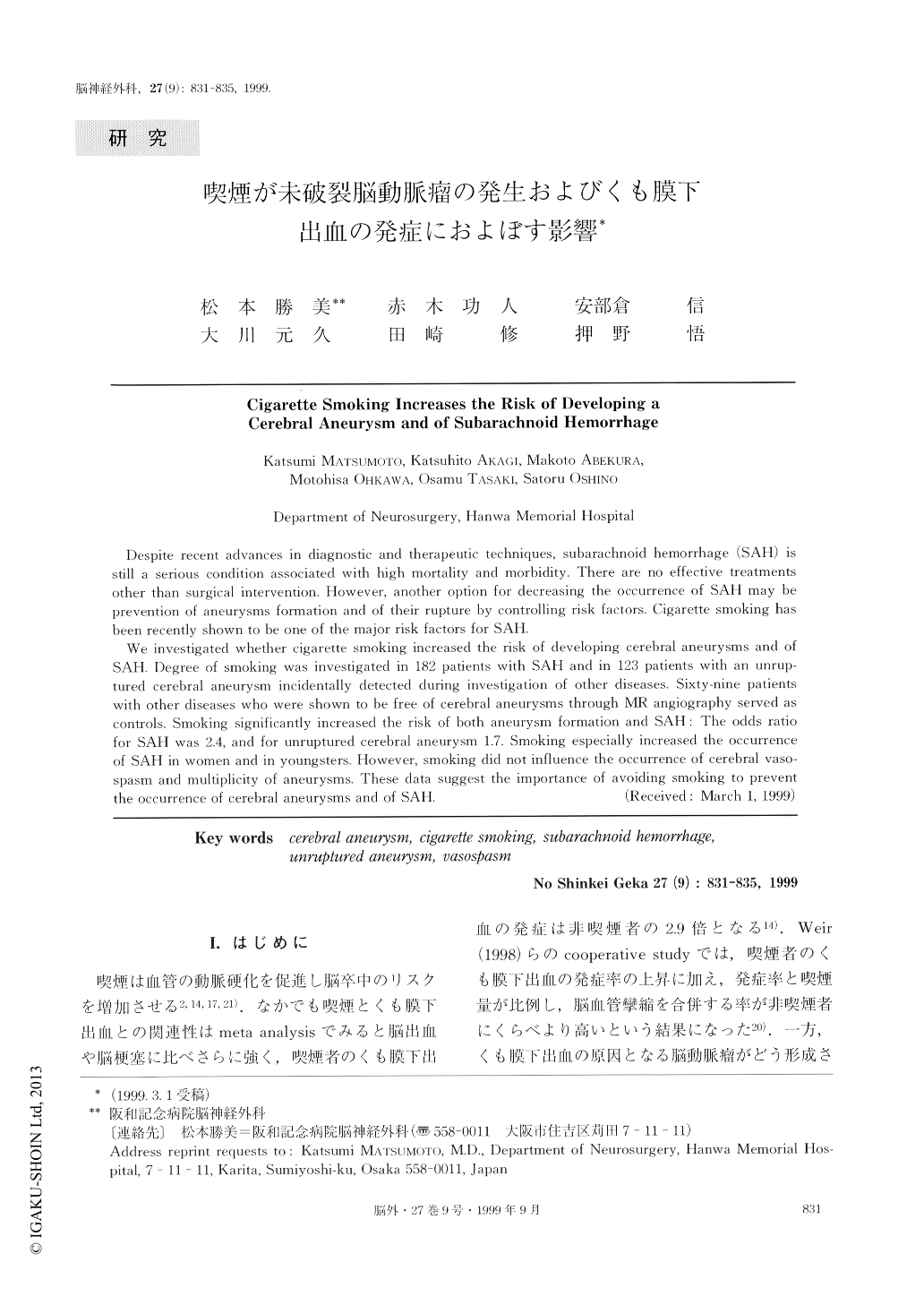3 0 0 0 OA 静脈洞血栓症に伴った水頭症の1成人例
- 著者
- 松本 勝美 滝本 洋司 正木 伸 中谷 進
- 出版者
- The Japan Neurosurgical Society
- 雑誌
- Neurologia medico-chirurgica (ISSN:04708105)
- 巻号頁・発行日
- vol.26, no.6, pp.491-494, 1986-06-15 (Released:2006-09-21)
- 参考文献数
- 31
A case of thrombosis of the dural sinus resulting in hydrocephalus is reported. This 60-year-old female had suffered from chronic right otitis media for 40 years. Recently she suddenly developed headache, vertigo and vomiting. The otitis media was treated surgically and with antibiotics. Thrombosis of the right sigmoid sinus was found at the time of operation. Headache persisted after the operation. Postoperative computed tomography (CT) scan showed ventricular dilatation and periventricular lucency. Cerebral angiography revealed stenosis of the superior sagittal sinus, the straight sinus, the right lateral sinus, and the right sigmoid sinus. After a ventriculo-peritoneal shunt operation, her symptoms and hydrocephalus were alleviated. It was suggested that hydrocephalus in this case was induced by sinus hypertension associated with dural sinus thrombosis secondary to recurrent otitis media. This phenomenon is known to occur usually in infants, but rarely in adults. Possible mechanisms accounting for the development of hydrocephalus secondary to sinus hypertension are discussed.
1 0 0 0 OA 腰椎後方固定術後のMRSAによる手術創部感染に対する抗菌剤療法
- 著者
- 佐々木 学 梅垣 昌士 鶴薗 浩一郎 松本 勝美 芝野 克彦 呉村 有紀 米延 策雄
- 出版者
- 日本脊髄外科学会
- 雑誌
- 脊髄外科 (ISSN:09146024)
- 巻号頁・発行日
- vol.30, no.2, pp.170-175, 2016 (Released:2016-09-03)
- 参考文献数
- 14
- 被引用文献数
- 2
Objective : Surgical site infection (SSI) caused by methicillin-resistant Staphylococcus aureus (MRSA) after spinal instrumentation surgery is often intractable, and removal of the implants is frequently necessary for infection control. Although vancomycin (VCM) has been most frequently used against SSI caused by MRSA, recent literatures questioned its efficacy because of its low tissue penetration. Some experts recommend combination therapy with anti-MRSA agents possessing higher tissue penetration or an anti-biofilm effect. The present report shows outcomes of antibiotic therapy for SSI caused by MRSA after spinal instrumentation surgery. Materials and methods : From January 2011 to December 2013, four patients developed SSI caused by MRSA after spinal instrumentation surgery. Posterior lumbar interbody fusion was used in all patients. As initial therapy, VCM was given to one patient, and combined teicoplanin (TEIC) and rifampicin (RFP) were administered to the other three. These patients subsequently received therapy with TEIC, linezolid, or daptomycin combined with RFP, sulfamethoxazole-trimethoprim, or clindamycin. These agents were stopped sequentially if C-reactive protein remained negative for more than a week. Results : Infection was uncontrolled in one patient initially treated with VCM, and removal of the posterior instrumentation and interbody cages was required for infection control. Combined therapy was given postoperatively, with complete cure by 13 weeks after removal of the implants. Infection was controlled and the implants could be retained in the other three patients who were initially treated with TEIC and RFP ; cure was achieved with subsequent combined therapy for 3-15 weeks. Conclusion : The present study suggests that SSI caused by MRSA is treatable with retention of the implant by using combined therapy with anti-MRSA agents possessing higher tissue penetration than VCM or those with an anti-biofilm effect.
1 0 0 0 OA 病態に合わせたPLIFとTLIFの術式選択についての検討
1 0 0 0 喫煙が未破裂脳動脈瘤の発生およびくも膜下出血の発症におよぼす影響
- 著者
- 松本 勝美 赤木 功人 安部倉 信 大川 元久 田崎 修 押野 悟
- 出版者
- 医学書院
- 雑誌
- Neurological Surgery 脳神経外科 (ISSN:03012603)
- 巻号頁・発行日
- vol.27, no.9, pp.831-835, 1999-09-10
I.はじめに 喫煙は血管の動脈硬化を促進し脳卒中のリスクを増加させる2,14,17,21).なかでも喫煙とくも膜下出血との関連性はmeta analysisでみると脳出血や脳梗塞に比べさらに強く,喫煙者のくも膜下出血の発症は非喫煙者の29倍となる14).Weir(1998)らのcooperative studyでは,喫煙者のくも膜下出血の発症率の上昇に加え,発症率と喫煙量が比例し,脳血管攣縮を合併する率が非喫煙者にくらべより高いという結果になった20).一方,くも膜下出血の原因となる脳動脈瘤がどう形成され破裂するかについては,hemodynamic factorや,中膜欠損,高血圧の影響など複数の要因が提唱されている7,11,18)が,喫煙がどう影響するかのメカニズムについてはいまだに解明されていない.また喫煙が動脈瘤の形成に関与するのか,破裂に関与するのかも明確ではない.今回くも膜下出血例および未破裂脳動脈瘤症例について,脳ドック受診者で動脈瘤が否定された症例をコントロールとし喫煙率の違いについて調査した.本研究の結果について喫煙が動脈瘤の形成や破裂に及ぼす影響について文献的考察を加え検討した.
1 0 0 0 OA 椎骨脳底動脈閉塞に対する急性期血行再建の治療成績
- 著者
- 松本 勝美 山本 聡 鶴薗 浩一郎 竹綱 成典
- 出版者
- 一般社団法人 日本脳卒中学会
- 雑誌
- 脳卒中 (ISSN:09120726)
- 巻号頁・発行日
- vol.31, no.3, pp.152-156, 2009 (Released:2009-06-30)
- 参考文献数
- 14
- 被引用文献数
- 1 2
[背景,目的]椎骨脳底動脈閉塞は発症より6時間以上経過して診断されるケースが少なくなく,血栓溶解を施行するかどうか判断が困難な症例が多い.今回椎骨脳底動脈閉塞例に対し血行再建を行った例について,再開通の有無,重症度および治療開始時間が予後に及ぼす影響を検討した. [症例と方法]当院での椎骨脳底動脈閉塞に対する血行再建は発症時間にかかわらず,diffusion MRIで梗塞の面積が20 ml以下または脳幹全体が高信号になっていない例としているが,該当症例は19例あり,12例は発症6時間以内に血行再建が行われ,7例は発症6時間以降に血行再建が行われた.各群について初診時NIHSSと3カ月後のmRS(modified Rankin scale)の関連性を検討した.再開通の評価はTIMI分類で施行した.統計はmRSと年齢,再開通までの時間,NIHSSは分散分析を行い,開通の有無とmRSは分割表分析を行った. [結果]予後は再開通の有無が最も影響し,TIMI分類のGrade 3∼4の11例中9例でmRSが3以下であったが,Grade 0∼1では全例mRSが4以上であった(P<0.01).発症時間,受診時NIHSS,年齢と予後の関係は有意差は認められなかったが,mRS 0∼1の4症例はいずれも発症3時間以内の再開通例であった. [結論]椎骨脳底動脈閉塞は発症時間にかかわらず,diffusion MRIで広範囲に高信号を呈さなければ血栓溶解療法の適応はある.発症時間からの経過にかかわらず再開通後の予後は比較的良好である.神経症状を残さない結果を得るには発症3時間以内の早期再開通が望ましい.

